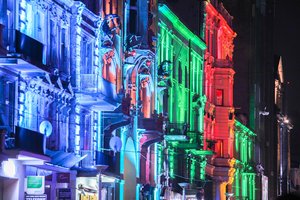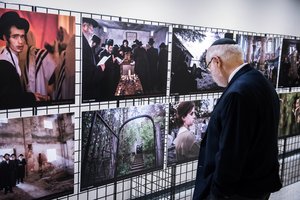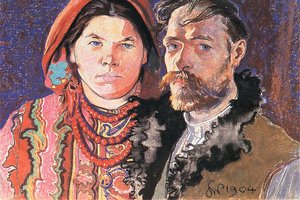The virtuosity of Master Veit
Veit Stoß began work on the main altar of the Church of St. Mary in late May 1477. He came to Krakow from Nuremberg to work on would become his magnum opis, one of the most magnificent achievements of European art in the late Middle Ages. The altar had a turbulent history. It was restored a couple of times. A team headed led by Dr Jarosław Adamowicz has worked since 2015 on restoring its former glory.
The altar’s restauration is a valuable opportunity for historians to carry out research on late Gothic art as well as the wood-carving and painting technique of Veit Stoß. According to Dr Adamowicz, the greatest discovery was that the majority of architectural elements forming the altar’s top, which until now were thought to be 19th-century reconstructions, are actually Gothic originals.
3D scans of altar parts
The restoration work is now being carried out on six scenes of the altar’s fixed wings, and the back of the chancel serves as a workshop. Every day the conservators climb a special scaffolding and spend long hours in an effort to preserve parts of the altar millimetre by millimetre and restore their former glory. The works do not disrupt the liturgical rhythm of the church. Mass is held until noon, then the church becomes crowded with tourists.
“We made a 3D scan and a full inventory of the altar in 2012. Thanks to this we were able to print out life-size photographs on stiff panels and we covered the places from which all low reliefs have been removed with them,” the head of the conservation team said in his talk with the “Gazeta Polska Codziennie” daily.
 Renovation worth 14 million zlotys
Renovation worth 14 million zlotys
Today we are able to admire the top of the altar which was renovated half a year ago.
“There are no easy solutions when working with a masterpiece of this class, with such a rich history,” says Dr Adamowicz. Carried out by the Interacademic Institute of Conservation & Restoration of Art at the Warsaw and Krakow Academies of Fine Arts, the complex research and conservation of the altar will last until 2021 and will cost nearly 14 million zlotys. Part of this sum is being donated by the Social Committee for Restoration of Krakow’s Historical Monuments and the Ministry of Culture & National Heritage.
This work is being done by the best experts and we are convinced that public funds are being spent reasonably,” said Minister Piotr Gliński, who met with the conservators.
The minister stressed that the Ministry of Culture & National Heritage will continue to support the renovation of the altar.
“The conservation was initiated in 2015 by our predecessors and we are continuing it. This is a responsibility beyond political divisions,” Deputy Prime Minister Gliński pointed out.
Veit Stoß’s lost fortune
“Dynamism of form, pathos and anxiety inherent in the late Gothic which muffles milder notes of lyricism might be the most appropriate way to describe the style of this work of art. It reflects a pellucid, tense struggle between the Middle Ages which are fading away and new powers which are coming to life,” Professor Tadeusz Dobrowolski, a prominent scholar, described Stoß’s masterpiece.
The altar was built in 12 years (1477-1489). The church was consecrated around the year 1320 and it had a different altar earlier on which was destroyed when the chancel’s vault collapsed. Donations were collected for a few years to erect an altar that would be worthy of the capital and royal city of Krakow.
The work was undertaken by Veit Stoß, a student of Nikolaus Gerhaert van Leyden. He received 2808 florins in remuneration for his work, which equated with a year’s budget of Krakow. His outstanding work brought him fame and fortune. But he lost both when he returned to Nuremberg. He was talked into putting the whole amount in a swindler’s bank. The Master was defrauded of all his earnings. In an attempt to rescue at least some of his savings, he forged a cheque and was caught. He was severely punished by cheek branding.
German plunder
The fate of the altar itself was also turbulent. During the World War, the Altar was plundered by the Germans and transferred to the Reich. It was kept in appalling conditions in the basement of the Nuremberg Castle. It was recovered after the war, but it was in a lamentable state. Thanks to the conservation work we can admire the masterpiece as it was made by Veit Stoß.
On 9 June 1979 in his address to the nuns gathered in the Church of St. Mary, St. John Paul II said: “My conscience would not be at peace as to whether I truly was in Krakow if I did not see the Basilica of St. Mary. It is filled with so much beauty, so much expression, so much atmosphere of prayer, so much mystery of the Virgin Mary and so much Polish spirit! I am happy to see the entry to the Basilica unveiled (…) and to be able to look at Veit Stoß’s triptych while crossing the church straight from the entry and to marvel at it, at its Gothic beauty which was left to us by the past in the very heart of Krakow.”
Source: “Gazeta Polska Codziennie”

07.06.2017







